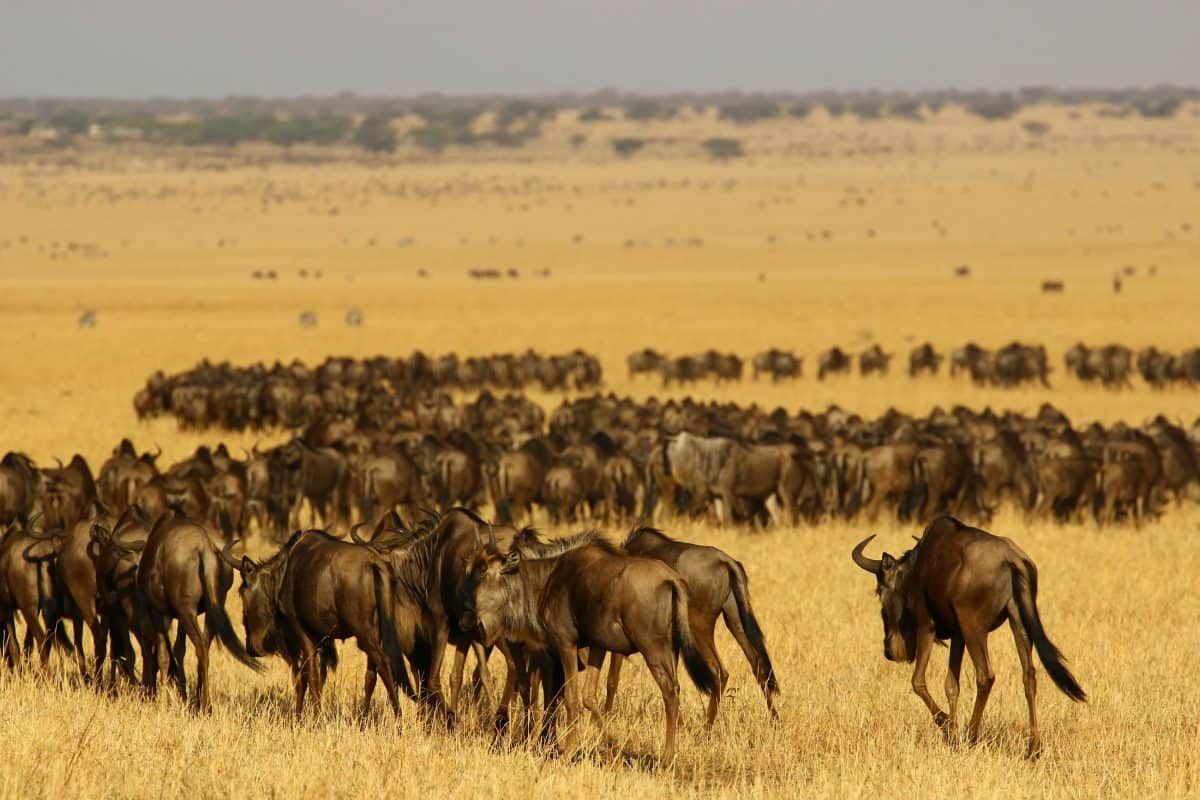
credit;SWNS
One of the largest ecosystems in the world is at risk because human activity along its borders has increased fourfold.
Iconic animals such as wildebeest, zebra, and gazelles are threatened by surge in human population on the borders of the Masai Mara and Serengeti national parks.
The Serengeti-Mara spans 40,000 square kilometres across Tanzania and Kenya and is the focus of mass migrations.
Every year a million wildebeest, half a million gazelle and 200,000 zebra make the perilous trek from the Serengeti in Tanzania to the Maasai Mara reserve in Kenya to search for water and grazing land.
The area is highly protected to guard against risks such as poaching, climate change and drought.
But an international team of scientists say increased human activity along the boundaries is posing a new risk and has a detrimental impact on plants, animals, and soils.
Scientists looked at 40 years of data and found that some boundary areas have seen a 400 per cent increase in human population over the past decade while larger wildlife species in key areas of Kenya have declined by more than 75 per cent.
Population growth and an influx of livestock in park buffer zones is believed to have squeezed the area available for migration.
As a result animals graze on less nutritious grasses than they did in the past and there are less natural fires in these areas.
The absence of these fires changes vegetation and alters grazing opportunities for other wildlife.
These effects are cascading down the food chain, according to the study, and favouring less palatable plants.
This alters the interaction between plants and microorganisms that enable the ecosystem to capture and utilise essential nutrients.
This could make the ecosystem less resilient to drought or further climate change, the scientists warn.
The authors conclude that even for reasonably well-protected areas like the Serengeti and Mara, alternative strategies may be needed to facilitate the co-habitation of local people and wildlife.
The current strategy of increasingly hard boundaries may be a major risk to both, they say.
Published in the journal Science, the study was led by the University of Groningen in Holland with collaborators at 11 institutions around the world, including the universities of York, Glasgow and Liverpool.
Dr Michiel Veldhuis, lead author of the study from the University of Groningen, said: “There is an urgent need to rethink how we manage the boundaries of protected areas to be able to conserve biodiversity.
“The future of the world’s most iconic protected area and their associated human population may depend on it.”
“This finding alters our view on what is needed to protect biodiversity.”
Dr Colin Beale, from the University of York’s Department of Biology, said: “Protected areas across East Africa are under pressure from a wide range of threats.
“Our work shows that encroachment by people should be considered just as serious a challenge as better known issues such as poaching and climate change.”
Dr James Probert from the University of Liverpool said: “It is clear that even large protected areas, with strict restrictions on what human activities can take place, can be indirectly affected by human populations at their boundaries.
“The Serengeti-Mara is one of the largest trans-boundary protected area complexes in the world, and yet we find the negative impacts of human activities impacting its core.”
Dr Joseph Ogutu from the University of Hohenheim said: “The intense compression of a large protected area, such as the Serengeti-Mara, should ring alarm bells because most other protected areas are far smaller in size and therefore experience even more intense pressures from human activities impinging on their borders.
“In countries where far more wildlife are still found outside than inside protected areas, such as Kenya where more than 65% of wildlife occur outside protected areas, expanding human population size, livestock and human activities pose serious and unprecedented threats to wildlife populations.”
Dr Simon Mduma, Director of the Tanzanian Government’s Wildlife Research Institute added: “These results come at the right time, as the Tanzanian government is now taking important steps to address these issues on a national level.
“This paper provides important scientific evidence of the far ranging consequences of the increased human pressures around the Serengeti-Mara ecosystem, information that is now urgently needed by policy makers and politicians.”